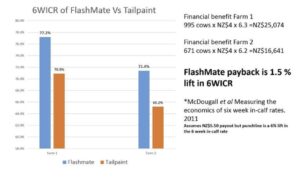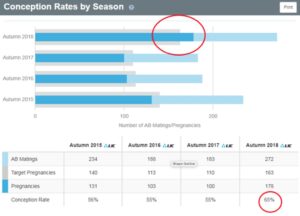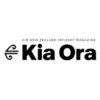"We've done the work"


In October 2014 a large independent clinical study of 1,466 cows demonstrated a lift in six week in-calf rate across several farms with FlashMate when compared to good managers using paint in the control. Clearly, FlashMate requires lower skill and labour input.
Cows in real commercial dairy herds in the Waikato region were paired by age, breed, calving date and one of each pair was randomly assigned a FlashMate so that 50% of the herd had FlashMates and the control group just had paint as per normal practice. The probability of pregnancy by 6 weeks following PSM (Preg6w) was compared.
Cows fitted with a FlashMate units on both farms had a higher probability of preg6w than their counterparts in the control group (Farm A, 77.2±2.1% and 70.9±2.4%, P=0.04, respectively) and (Farm B, 70.1±2.1% and 66.9±2.4%, P=0.04, respectively).*
The outcome was that cows fitted with FlashMate had a 6% higher 6WICR than those with just paint. The farms in this clinical study would have paid for FlashMate more than four times over in their first season alone.
It is noted that both farms acknowledged that they did not always breed to the FlashMate alert as per the protocol and so the performance of FlashMate is likely to be underreported in this study. It is acknowledged that farm B ended the AB period at 5 weeks rather than 6 which will have likely reduced the reported performance on preg6w of the FlashMate treated group. At the same time study and control groups were mixing and forming sexually active groups including FlashMate alerting cows. Thus the control groups also improved during the period of the study, closing the performance gap somewhat.
*Note this result does not necessarily mean that a farm will increase its 6WICR by 6% or more compared to the previous year. Different periods cannot be reliably compared because of many uncontrollable variables. But that there is a statistically significant probability that FlashMate would improve six week in-calf rate compared to what would be achieved without FlashMate within that same season.
Below are some examples of real farm results.
Suffolk North Farm. Herd size =269. Saw increase in 6WICR = 10% (60% to 70%), decrease in empty rate = 3% (19% to 16%). Profit from increase in 6WICR =$10,760, profit from decreasing not-in-calf-rate=$8,070. Total increase in profit from 2017-2018 year = $18,830. Cost of FlashMates =$2,318
Brackley Dairy. Herd size =234. Saw increase in 6WICR = 14% (62% to 76%), decrease in empty rate = 5% (22% to 17 %). Profit from increase in 6WICR =$13,104, profit from decreasing not-in-calf-rate=$11,700. Total increase in profit from 2017-2018 year = $24,804. Cost of FlashMates =$2,024
DNA Farms Autumn 2017. Herd size =529. Saw increase in 6WICR = 10% (56% to 66%), decrease in empty rate = 13% (32% to 19%). Profit from increase in 6WICR =$21,160, profit from decreasing not-in-calf-rate=$68,770. Total increase in profit from 2016-2017 year = $89,930. Cost of FlashMates =$4,576
DNA Farms Autumn 2018. Herd size =536. Saw increase in 6WICR = 7% (66% to 73%), decrease in empty rate = 4% (19% to 15%). Profit from increase in 6WICR =$15,008, profit from decreasing not-in-calf-rate=$21,440. Total increase in profit from 2017-2018 year = $36,448. Cost of FlashMates =$4,636
Below is real farm results from another farm (Not DNA Farms) with conception rate stable at 55% and jumping to 65% with first use of FlashMate. When noting the lift in the in-calf rates, consider also that within the lift in the 6 week in-calf rate, the increased conception rate `front-loaded’ conceptions to the first cycle. This puts additional milk in the vat.


The Land Farm Group Downloaded FlashMate data from half of the cows as a large representative sample n=514. Conception rates to 1st service on the FlashMate alerts was 14% higher at 65% than the national average. 27 ‘silent heats’ inseminated on FlashMate alert with no paint rub with 63% conception rate. 17 pregnancies extra is worth a 1.8% lift in 6wicr worth $6,905. Head to head clinical studies show that the number of heats that would have been missed without FlashMate is actually in the order of 12% or more. 23 cows were not bred to very strong heats indicated by FlashMate. 10 of these 23 cows ended up empty. Economic loss $9,200 at $400 per missed heat but actually much higher as 10 of 23 ended up empty. Full herd economic impact ~$18,400 loss. Some cows were bred while pregnant which the literature shows risks aborting an existing pregnancy. Some of these cows did not conceive again and ended up empty. Of the 23 cows recorded in heat with no FlashMate alert only 1 cow actually conceived (4.3% conception rate). If just the FlashMate alerts were bred to then the overall false positive rate would have reduced significantly requiring (13%) (67/514) less straws without reducing the number of pregnancies. This equates to roughly 130 straws not being required 130 X $18.50 = $2,405 saved. Staff can have a mixed range of heat detection skills and their ability shifts as the season progresses (heat detection fatigue). FlashMate is a way to standardise heat detection to a high level of accuracy regardless of the staff member doing the job on any given day.
FlashMate has been (or is currently being) used in the following countries:
- United Kingdom
- Chile
- Ireland
- South Africa
- Columbia
- USA
- Japan,
- Fiji
- China
- Vietnam
- Brazil
- Russia
- Estonia
Lucy, M.C. 2018. Selection for fertility in the modern dairy cow – Current status and future direction for genetic selection. J. Dairy Sci. 102:1–16
F G Kumro et al 2020. Simultaneous measurements of estrus behavior and plasma concentrations of estradiol during estrus in lactating and nonlactating dairy cows. J. Dairy Sci. 104(2): 2445-2454
F G Kumro et al 2020. Estimates of intra- and interclass correlation coefficients for rump touches and the number of steps during estrus in postpartum cows. 104(2):2318-2333
S.G Moore, V Aublet, S.T Butler. 2021. Monitoring estrous activity in pasture-based dairy cows. Theriogenology 2021 Jan 15;160:90-94
Full clinical work has been undertaken with FlashMate in the following countries; New Zealand, Canada, USA, Japan, UK, and Ireland.
Following stringent multi-year evaluation work at the Kumamoto Japanese Government Research Station, FlashMate has been approved for use in Japan.
In Canada a 74% conception rate was demonstrated, 56% of inseminations were with sexed semen. FlashMate alerted an additional 31% not otherwise observed in standing heat. 82% of these extra alerted heats resulted in pregnancies.

“I was an AI technician for 17 years and use quite a bit of sexed semen. We’ve used FlashMates for five seasons. We rely on them. We haven’t put any bulls out at all.”
Wayne Taylor
Board Member and former President of Holstein Fresian NZ
“Our empty rates have dropped a lot… you’re not getting that embryonic loss. We’re picking up silent heats with hardly any marking on the tailpaint. It makes the FlashMates pretty cheap, more people should be using them. We’ve trialled neck collars and FlashMates are a lot more attainable.”
Robert Buchanan
Suffolk North Farm
“FlashMate appears to save a lot of money at no extra cost. Using FlashMate we picked up cows I would have missed and mating cows unnecessarily can be a huge cost. The biggest noticeable difference is the lack of short returns.”
Erik Lenssen
Canterbury
“It’s a lot easier for the staff to see a light flashing than look at tailpaint. It’s less stressful than having to get up every morning to have a look and they’re not that expensive. They’re certainly picking up the silent heats. Easy to apply, easy to operate; it didn’t take any longer than tailpaint!”
John Tanner
Leeston, Canterbury
“Very simple for inexperienced people to make good decisions, tail paint can be subjective. I’ve had some comfort handing over to four of the guys on the farm, for one person to consistently get up at 4:30am is a big ask. We only had 10 out of 800 cows that came off over four weeks, so that was an exceptional result.”
Angela and Steve Reed
Darfield, Canterbury
“You're just crazy if you don't use them.... so far it's the best thing that I've seen. Normally over mating I would not have a single day off. But with Flashmate, I was able to. What impressed me the most was when we checked over the pregnancy results. A lot of cows were in-calf to the first mating. They had been accurately identified first time, even the ones that did not rub with tail paint. It would have been the best 4-week-in-calf we have ever had.”
Hamish Maclean
Manuwaru, Waikato
“With autumn-calving, cows are harder to pick. Using FlashMate we picked up cows we wouldn’t have seen. My 4 year daughter could pick cows! I had none come off the cows in the first six weeks and felt very comfortable that the right cows were going up for AB. It also gives you the delayed flash for when they’re actually on heat, rather than putting them up too early. I definitely felt it was an added edge in heat detection.”
Shaun Gardner
Waiiti, Taranaki


FlashMate has featured in












"We've done the work"


In October 2014 a large independent clinical study of 1,466 cows demonstrated a lift in six week in-calf rate across several farms with FlashMate when compared to good managers using paint in the control. Clearly, FlashMate requires lower skill and labour input.
Cows in real commercial dairy herds in the Waikato region were paired by age, breed, calving date and one of each pair was randomly assigned a FlashMate so that 50% of the herd had FlashMates and the control group just had paint as per normal practice. The probability of pregnancy by 6 weeks following PSM (Preg6w) was compared.
Cows fitted with a FlashMate units on both farms had a higher probability of preg6w than their counterparts in the control group (Farm A, 77.2±2.1% and 70.9±2.4%, P=0.04, respectively) and (Farm B, 70.1±2.1% and 66.9±2.4%, P=0.04, respectively).*
The outcome was that cows fitted with FlashMate had a 6% higher 6WICR than those with just paint. The farms in this clinical study would have paid for FlashMate more than four times over in their first season alone.
It is noted that both farms acknowledged that they did not always breed to the FlashMate alert as per the protocol and so the performance of FlashMate is likely to be underreported in this study. It is acknowledged that farm B ended the AB period at 5 weeks rather than 6 which will have likely reduced the reported performance on preg6w of the FlashMate treated group. At the same time study and control groups were mixing and forming sexually active groups including FlashMate alerting cows. Thus the control groups also improved during the period of the study, closing the performance gap somewhat.
*Note this result does not necessarily mean that a farm will increase its 6WICR by 6% or more compared to the previous year. Different periods cannot be as you cannot reliably compared because of many uncontrollable variables. But that there is a statistically significant probability that FlashMate would improve six week in-calf rate compared to what would be achieved without FlashMate within that same season.
Below are some examples of real farm results.
Suffolk North Farm. Herd size =269. Saw increase in 6WICR = 10% (60% to 70%), decrease in empty rate = 3% (19% to 16%). Profit from increase in 6WICR =$10,760, profit from decreasing not-in-calf-rate=$8,070. Total increase in profit from 2017-2018 year = $18,830. Cost of FlashMates =$2,318
Brackley Dairy. Herd size =234. Saw increase in 6WICR = 14% (62% to 76%), decrease in empty rate = 5% (22% to 17 %). Profit from increase in 6WICR =$13,104, profit from decreasing not-in-calf-rate=$11,700. Total increase in profit from 2017-2018 year = $24,804. Cost of FlashMates =$2,024
DNA Farms Autumn 2017. Herd size =529. Saw increase in 6WICR = 10% (56% to 66%), decrease in empty rate = 13% (32% to 19%). Profit from increase in 6WICR =$21,160, profit from decreasing not-in-calf-rate=$68,770. Total increase in profit from 2016-2017 year = $89,930. Cost of FlashMates =$4,576
DNA Farms Autumn 2018. Herd size =536. Saw increase in 6WICR = 7% (66% to 73%), decrease in empty rate = 4% (19% to 15%). Profit from increase in 6WICR =$15,008, profit from decreasing not-in-calf-rate=$21,440. Total increase in profit from 2017-2018 year = $36,448. Cost of FlashMates =$4,636
Below is real farm results from another farm (Not DNA Farms) with conception rate stable at 55% and jumping to 65% with first use of FlashMate. When noting the lift in the in-calf rates, consider also that within the lift in the 6 week in-calf rate, the increased conception rate `front-loaded’ conceptions to the first cycle. This puts additional milk in the vat.


The Land Farm Group Downloaded FlashMate data from half of the cows as a large representative sample n=514. Conception rates to 1st service on the FlashMate alerts was 14% higher at 65% than the national average. 27 ‘silent heats’ inseminated on FlashMate alert with no paint rub with 63% conception rate. 17 pregnancies extra is worth a 1.8% lift in 6wicr worth $6,905. Head to head clinical studies show that the number of heats that would have been missed without FlashMate is actually in the order of 12% or more. 23 cows were not bred to very strong heats indicated by FlashMate. 10 of these 23 cows ended up empty. Economic loss $9,200 at $400 per missed heat but actually much higher as 10 of 23 ended up empty. Full herd economic impact ~$18,400 loss. Some cows were bred while pregnant which the literature shows risks aborting an existing pregnancy. Some of these cows did not conceive again and ended up empty. Of the 23 cows recorded in heat with no FlashMate alert only 1 cow actually conceived (4.3% conception rate). If just the FlashMate alerts were bred to then the overall false positive rate would have reduced significantly requiring (13%) (67/514) less straws without reducing the number of pregnancies. This equates to roughly 130 straws not being required 130 X $18.50 = $2,405 saved. Staff can have a mixed range of heat detection skills and their ability shifts as the season progresses (heat detection fatigue). FlashMate is a way to standardise heat detection to a high level of accuracy regardless of the staff member doing the job on any given day.
FlashMate has been (or is currently being) used in the following countries:
- United Kingdom
- Chile
- Ireland
- South Africa
- Columbia
- USA
- Japan,
- Fiji
- China
- Vietnam
- Brazil
- Russia
- Estonia
Lucy, M.C. 2018. Selection for fertility in the modern dairy cow – Current status and future direction for genetic selection. J. Dairy Sci. 102:1–16
F G Kumro et al 2020. Simultaneous measurements of estrus behavior and plasma concentrations of estradiol during estrus in lactating and nonlactating dairy cows. J. Dairy Sci. 104(2): 2445-2454
F G Kumro et al 2020. Estimates of intra- and interclass correlation coefficients for rump touches and the number of steps during estrus in postpartum cows. 104(2):2318-2333
S.G Moore, V Aublet, S.T Butler. 2021. Monitoring estrous activity in pasture-based dairy cows. Theriogenology 2021 Jan 15;160:90-94
Full clinical work has been undertaken with FlashMate in the following countries; New Zealand, Canada, USA, Japan, UK, and Ireland.
Following stringent multi-year evaluation work at the Kumamoto Japanese Government Research Station, FlashMate has been approved for use in Japan.
In Canada a 74% conception rate was demonstrated, 56% of inseminations were with sexed semen. FlashMate alerted an additional 31% not otherwise observed in standing heat. 82% of these extra alerted heats resulted in pregnancies.
FlashMate has featured in















